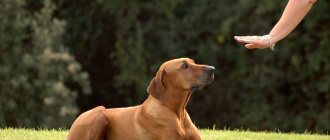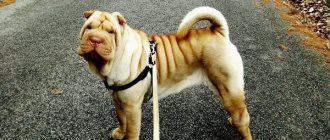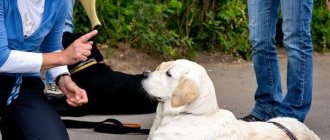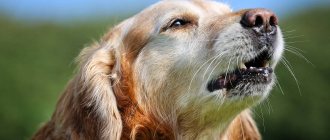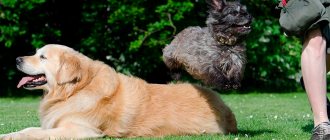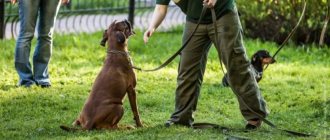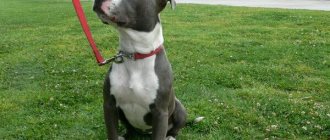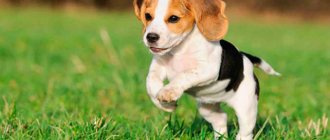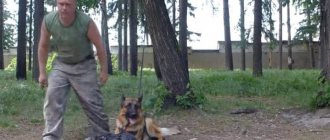The course has been updated in June 2022! Many improvements have been introduced.
Learn basic training skills for your dog online! The best option for taking the first steps in education. The videos were filmed by Irina Chushikina, a dog handler with 10 years of experience.
| Number of videos | Price |
| One lesson | 1,000 rub. |
| Entire course (5 lessons) | 6,000 rub. 5,000 rub. |
The most important commands
Not all of them are equally useful in the life of the owner and his pet. Babies under 3 months old will not benefit from “adult” training methods at home. Puppies are trained according to programs. These instructions are relevant to owners of animals older than 3 months.
Each of them is important. Even the most seemingly “insignificant” of them cannot be ignored. On the contrary, it is worth further familiarizing yourself with each technique.
Must know and perform:
Take the Attention Test! Find 10 differences! (click right here!)
Find the answer Are you bothered by some problem or question? Enter “Breed” or “Name of the problem” into the form, press Enter and you will find out everything about the issue that interests you.
- "To me". This is the most famous team. It is used more often than others. Learning the technique can be practiced during class or during a regular walk.
- "Near". Almost as important as “to me.” Animals usually learn it by the 4th-5th lesson.
- "Ugh". It will help you not to worry that your dog will get into the trash heap or eat, say, rodent poison. Extremely important for the health of the pet and the nervous system of the owner.
- It is worth starting to develop endurance in a four-month-old puppy. Not a single serious activity with a pet can be done without it. Self-control helps control the dog and develops the animal’s obedience.
- "Give". Useful for every well-mannered dog. For ministerial servants who make protecting their household their life's goal, this technique is important. An animal that perfectly executes “give” can neutralize an attacker on its owner and then release it.
It is used when playing with a thrown toy and a stick. Experts do not recommend teaching your dog the “give a paw” technique. Dogs quickly learn this and begin to “hello” their owner every time he bends down.
- "Sit". The simplest command that can be useful in everyday life or for training itself.
- "Lie". It is easy to teach a pet. You may need it, for example, at a veterinarian’s appointment.
- "Stand". This one is more complicated. Although it is used more often than "sit". Beginners are often lost when learning; patience and perseverance should help them master a useful exercise.
- "Place". It is useful for a dog to know where its place is in the house and to go there on command. The dog may sleep in a completely different place, but he must know his own.
- "Aport." Helps you walk your active pet. With its help, service dogs search the area.
- "Fas." A dangerous command if the dog does not know how to obey. An untrained dog cannot be trained.
This is what the list for the basic pet training course looks like. To make classes more effective, you need to stock up on treats for your “student”. It should be something tasty for the dog and easy to carry. Everyday pet food is not suitable; the dog understands well that he will receive it without additional effort.
Rules and methods for teaching dogs commands
There is an opinion that it is impossible to train an adult dog: supposedly, it is possible to master all stages of the training course only in puppyhood. It's a delusion. Of course, kids learn faster and absorb information more easily, but adult dogs can also be trained. The main thing is to conduct training regularly, competently and be patient, not to get nervous when an adult dog does not learn a lesson very quickly.
It is best to conduct training in a place familiar to your pet. It is desirable to have no distractions: cars, passers-by, other dogs, etc. If an unfamiliar territory is chosen, the animal must first study it, examine it, in order to eliminate possible dangers and calm down.
You should not conduct training immediately after waking up or after eating. During the summer, it is not recommended to train in the middle of the day, as this can cause dehydration, overheating and all related problems. If there is no other option, take enough drinking water for your pet.
Don't forget to bring treats to class. Consider your pet's preferences. For some dogs, the most delicious thing is dry food, for others - a piece of meat or a slice of cheese. In pet stores you can buy special cookies for training purposes.
You can reward your dog not only with something tasty, but also with praise and affection. This must be done correctly. If you reward your pet for some action, you need to praise it right away. If the command has already been completed and some time has passed, the reward will be misunderstood by the pet.
If you decide to go through a training course with your pet yourself, pay attention to the following recommendations
:
- Classes should be regular, ideally daily. The duration of training should increase gradually. For the first lessons, 15 minutes is enough.
- Commands must be given clearly, with special intonations. The dog must distinguish between the intonations of commands and encouraging words.
- An order must be repeated no more than twice if the student did not complete it the first time, otherwise it will lose its value. The dog will think that fulfilling the requirement is not necessary, and it can be fulfilled the tenth time.
- Before you command, you need to attract the animal’s attention - say its name.
- You must not lose composure if your pet fails in training, become nervous, raise your voice, much less beat the animal.
- For success, do not forget to reward your four-legged friend with a kind word or a tasty bite.
Conduct initial classes in the same area. After the dog gets used to the training, the place can be changed.
Time, place, duration
Some lazy owners hope to get by with training at home. To be fair, commands such as “fu”, “lie down”, “nearby” can be taught easily. At home, a “trained” pet will learn to obey, but on the street it will prefer to behave as it sees fit: run after the cat or bury its head in a trash can.
A well-mannered dog needs real exercise in the fresh air. It’s worth stocking up on dog treats, taking a collar and leash, and going with your devoted pet to a place where no one should interfere. The first training sessions should take place in a quiet place. Gradually, exercises can be practiced with the participation of stimuli (people, other dogs.).
Classes must be systematic. Select 3 days a week. Let's say Tuesday, Thursday, Saturday. If you are very busy at work, you need to give your pet at least 2 days a week.
It is recommended to start with 35-45 minutes. In the future, classes should be increased to 1-1.5 hours. Roughly speaking, it will take 2-4.5 hours a week to raise a dog.
We begin the educational process:
- First training. The dog must learn the commands: “come to me”, “lie down”, “sit”, “next to me”. Get to know endurance. The technique of endurance and “come to me” should be practiced while walking with an animal.
- Second. The same exercises are processed as in the first one.
- Third. The command “stand” is added. The classes will be longer, they should be 45-60 minutes.
- Fourth. The emphasis is on execution technique.
- Fifth training session and that's it. Processing already familiar commands. You need to strive for perfect execution. A half-trained dog can sometimes be more dangerous than an untrained animal.
“Come to me” - practice at home and while walking the dog. It is worth calling the dog when he is lying down.
“Fu” is one of the useful ones. During exercise, you can scatter food around the training area yourself. Any attempt to eat the treat must be stopped with a strict “ew”. You need to pull the roulette leash sharply. The punishment for wrongdoing must be quite serious. After treatment, you can play with your pet or switch to another technique.
The “place” command can be taught to your dog both at home and on the street. At home, it is needed so that the pet goes “to itself.” And on the street, so that he returns to the previously designated place. It is used to train techniques such as “lying” or “sitting”. It is needed for the animal's obedience.
Techniques such as “give” or “fetch” begin to be taught while walking. At first they look like a game. Often they use a puller or rubber toys from the pet store. During classes, practice should take place in a more formal form, without the use of games.
As mentioned above, “fas” is a serious team. Only a specialist can teach it to a dog. Dog handlers are confident that the dog must be well-mannered and obedient. Experts, even with a perfectly trained dog, conduct several obedience training sessions before moving on to a protection course and learning it.
If we talk about the sequence of execution, the main rule is this: in order to quickly train your pet and work out all the techniques, the sequence should not be repeated.
In practice, the lesson might look like this:
- Work with the team “nearby” lasts up to 10 minutes;
- The same amount of time should be spent practicing the techniques of “standing”, “sitting”, “lying down”;
- You can repeat “next to”;
- Spend a little less than 10 minutes on exposure;
- Practice the “fetch” and “give” techniques for up to 10 minutes.
The next time you practice, the order may be different. This way the dog will quickly learn to carry out the necessary commands.
Paid dog training
Many of you want your dog to know many different commands, but you don’t have the time or energy for this. Therefore, many turn to training professionals, namely dog handlers. But not everyone will be able to afford to take their pet to dog handlers, because these services are paid. Many owners are interested in how much it costs to train a dog.
The price is different for everyone, because:
- 1) it depends on the training program that you would like to undergo for your pet;
- 2) qualifications of the trainer himself;
- 3) the place where you will conduct your training.
Any breed of dog can be trained. It all depends on the desire and financial situation of the dog’s owner.
During the first lessons, the dog will be taught standard commands, such as: sit, lie down, next to me, not allowed, and others. If you plan for your pet to take part in competitions, then it is better to continue training more complex teams after standard training.
Upon completion of training, your pet will be issued a special certificate. With this document, your dog will have the opportunity to take part in competitions.
What should a novice trainer remember?
To prevent training from turning into torture, you need to consider a few more points:
- Any workout can be made easier. To do this, you need to take your pet for a good walk in advance. A tired, running dog will be less distracted. This means the effect will be greater. According to experienced owners, active walking makes working with the animal several times easier.
- Each command is spoken only once. They cannot be duplicated. The dog quickly grasps, if he understands that the owner can repeat the same thing several times, then he will stop performing the technique the first time.
- There must be pauses between teams. When practicing, for example, “near”, “lie down”, “fetch”, you need to give the dog time to take a breath. 5-10 seconds will be enough. If you do not pause, the dog may simply become confused.
- It's important to change the sequence. During training, it is better to practice all techniques separately. If the dog gets used to doing everything in order, nothing good will come of it in the end. Unless he develops a reflex. That, for example, after “to me” you need to “sit.” The dog must master commands in any sequence.
- You cannot overload your student. Too intense training can harm your four-legged friend. We must always keep in mind that a dog is a living creature. She may have some pain. Or not being in the mood to study.
An already trained dog is able to perfectly carry out commands under any conditions. But we must keep in mind that your pet may get tired.
- Sometimes students, like ordinary schoolchildren, “run away from class.” They may be distracted by a nearby cat or other dog. This can be avoided if you are more careful about exposure. Train her on a long leash. This will allow you to catch up with the “mischievous person”, even if he runs fast. A leash with a carabiner for 3-5 meters is suitable. Often such a leash is just needed for endurance and training to pick up “goodies” from the floor.
- “Mass” training is not allowed. Only the dog's owner should act as a trainer. The dog must obey all family members. And pets must master the basic principles of raising an animal. But at the training itself there are only two people: the owner and his pupil. Otherwise, the dog will be constantly distracted.
- Sometimes during training it is worth pausing. It happens that the dog looks scared. He follows commands, but seems to doubt the correctness of his actions. The reason is usually that the owner was too strict and overdid the load. In such cases, you need to get the dog to fulfill the simplest command for him, and then generously praise him. More than usually. The dog, seeing that the owner approves of him, will begin to perform the exercises better. You can even play with the dog or take it for a walk.
- To develop the ideal execution of techniques, they need to be studied systematically, gradually. It is necessary to teach your pet to follow commands in any conditions. Start with perfect obedience in a calm place, gradually adding “stimulants”. They can be created artificially. For example, scattering treats. Or invite a friend to walk past your training place at a certain time. You can come up with “irritants” yourself or read reviews from experienced owners.
To train an animal, you need to be patient, free up a few hours a week, and most importantly, do the exercises systematically. These are the basic rules that will help raise a trained dog from a “wild animal”. Further training can be complicated. You should get off the couch, take your pet for a walk, and go look for a suitable place for training.
How much does it cost to undergo OKD with a trainer?
Typically, courses are conducted with qualified dog handlers who require a fixed price for their services. The price range looks something like this:
- 7,000 rub. – average cost of group training;
- 16,000 rub. – a course of individual lessons with a trainer.
The prices are approximate, since the coach has the right to set an individual price depending on the region of residence and his own qualifications. So, for the money paid, the client will receive 16 classes in which the dog is present together with the owner. Training can take place in a group with other dogs or alone with a trainer for particularly obstinate dogs.
Prices for classes depend on the region of residence and the qualifications of the trainer.
Important! Sick dogs and bitches in heat are strictly not allowed to take the course. A dog in heat will distract other animals from training, and a fight may break out between the dogs.
A pleasant surprise or reward for work
During house training, the animal should be rewarded with a tidbit:
- Any correctly performed action is reinforced with encouragement, and the next repetition is perceived as a signal to action.
- Dogs who love to eat and food eaters perceive the reward of a treat well. But dogs that are not greedy for food quickly grasp the essence of the owner’s requirements.
- For treats, you usually take what the dog likes: hard cheese, cookies or sausage.
- It is pre-cut into small, pea-sized balls or pieces, and placed in a bag or a special bag hung on the belt. From such a bag it is convenient to take out treats one piece at a time, the small size of which prevents the dog from getting full and losing interest in activities.
The treat is given only after completion, and it must be taken out quickly and unnoticed by the pet.
Carrot or stick - which method to choose
A rhetorical question. Just 10-15 ago, all dog handlers spoke in unison about “dominance” and that a dog must respect its owner. Today, the situation has changed dramatically; an increasing number of animal psychologists are confident that you need to raise a dog through positivity .
Properly selected motivation makes the dog carry out commands with joy, which even looks more impressive. When a pet is raised without the use of a “whip”, he is absolutely confident in himself and has unlimited trust in his owner. By replacing the “carrot” with cruelty, there is a high chance of getting a frightened, nervous creature that, at any opportunity, tries to escape from its owner.
Differences in learning
There are no differences between training a German Shepherd at home and a dog of another breed, except that the ability to quickly remember commands and the desire to do everything perfectly put the German in first place.
From a very young age, German puppies want to learn. They quickly become accustomed to neatness, and even before 4 months of age they are able to perform “voice!”, give a paw, and several other requirements that the owner uses in everyday life.
A German Shepherd can begin to be trained at home as early as 4-5 months, and although this breed has an enviable temperament, they master commands for endurance from the very first lesson. Calling and fetching—dogs perform these tasks with great pleasure.
“Next” is a little more difficult to learn, because in parallel with training, ring training is often carried out for the puppy, in which he must walk, pulling on the leash. Teaching a German Shepherd the command “near!” start a little later than usual.
Useful tips from professionals
List of useful tips from a dog handler:
- You only need to say the command once (the only repeated command is “near”).
- Every action performed correctly must be rewarded (at the learning stage).
- Never punish a dog after calling “to me” (no matter how long, you don’t have to wait for it).
- Classes should be short-term, but daily.
- It is strictly forbidden to use corrective equipment for puppies under one year of age.
- The role of socialization in training should not be underestimated.
Raising a true companion is long and laborious, but it's worth it. A well-trained pet will not cause discomfort to others, and will not be in danger of urban conditions (escapes, cars). An obedient dog is the pride of a worthy owner.
3.7 / 5 ( 4 voices)
We train
Like small children, puppies of any breed love to play, so training babies at home is carried out in a playful way.
While walking, you can learn the command “come to me!” - the most important. Throughout his life, the dog should associate calling with pleasant stroking, treats and approval from the owner during training at home. If a dog has caused trouble but comes up on its own when called, it is prohibited to punish it!
Call the puppy when he calmly examines the surroundings. You need to sit down, take a treat in your hand and cheerfully call the baby. You can say a nickname, but only to attract the pet's attention. When the dog runs up, you need to treat him and praise him loudly. Periodically calling the puppy, reinforce the training.
An adult dog commands “come to me!” teach by stepping back from the dog a few steps and slightly tightening the leash. It is necessary for the animal to understand what is wanted from it.
If at first the puppy is required to simply run up, then the task becomes more difficult for an adult. When the dog approaches, you need to sit him in front of you, and only then give him a treat, or lead him around and sit him down. Refreshments are given only after landing.
Results
These commands are the most basic, after studying which you can begin to study the following, more complex commands.
IMPORTANT! The first training sessions for your puppy should be done indoors so that the animal is not distracted by strangers or other factors. After the dog learns to respond to its name and commands, you can move the training to the street.
Training a dog is a very labor-intensive and serious process that requires a careful approach and endless patience on the part of the owner. During the first training, it is necessary to monitor the puppy, paying attention to his preferences, in order to facilitate the training process in the future. The dog you love will definitely want to please you by following commands if it feels care and positive emotions from you.
Learning differences
It is possible to predict the extent to which a representative of the breed is able to quickly remember, patiently perform endurance exercises, or walk well next to each other.
Ability to learn at home depends on hereditary data, breed, and to a large extent, on the individual temperament and preferences of the pet. Both huge Newfoundlands and miniature Yorkshire terriers are trained at the same time on sites and at home, and there are no particular differences between the training methods. A dog of any breed is able to undergo OKD.
Character
The dog’s character, his temperament and individual inclinations play an important role in the success of training at home:
- Some dogs cannot sit still and are active, which means they need a short walk before training.
- Others are lazy and imposing, do not want to get up from their seats - they need to conduct classes in the morning.
- Stubborn, dominant pets should begin training as early as possible, so that by the time they reach puberty, the dog already understands who is in charge in the family. This applies to dogs of vicious breeds, which are easier to deal with while they are small. For example, a one-year-old Alabai who wants to show his character will be difficult to tame.
- Sensitive, vulnerable, emotional pets should be trained gently, without the use of harsh jerks and shouts. This applies to some decorative breeds, to bitches.
- In most breeds, sexual dimorphism is clearly expressed: females are always smaller than males and have a more sensitive and vulnerable character. When trained, bitches are more understanding, obedient, and prone to complete submission to the owner.
What is OKD?
The general training course (GTC) was developed by Soviet dog handlers about a century ago. This is a school that allows you to correct a dog’s behavior and instill unconditional obedience in it. The strict requirements that are imposed on each dog during the course are recognized as basic, and the level of proficiency in the standards is checked at all specialized competitions.
Definition of OKD
OKD has not lost its relevance all these years, surpassing all new techniques in its effectiveness. The course must be completed by:
- four-legged rescuers and police officers;
- service dogs;
- fighting dogs acting as a guard in a private home.
As a rule, fighting breeds are born with too much energy and hidden aggression. If they are not directed in the right direction with the help of OKD, the uncontrolled aggression of dogs will become dangerous for other animals and people. In addition, OKD is also suitable for ordinary pets. The courses will help owners establish good contact with their dog, gain complete control over it and receive only positive emotions from walks.
Courses help owners establish good contact with their dog
Deadlines
A dog can be trained at home from the age of 2 months.
First, the puppy is taught simple commands that are necessary in everyday life: “come to me!”, “show your teeth,” “walk!”, “sit,” “toilet.” If the dog lives in an apartment, then the “give me a paw” command is needed to wipe his paws after going outside. After a course of vaccinations, at 4 months, you can begin full training, making it a rule to work with your pet every day. Before the start of classes, the owner takes a treat and says: “practice!”
Soon the puppy will understand what this command means and will be ready for the next lesson, and all kids approach this differently. The lazy ones look disappointed, the “excellent” students jump joyfully in anticipation.
With or without a leash
The leash serves as an extension of the owner's hand; with its help, a person can easily control the dog, even at a distance of several meters.
With the leash you can jerk, pull and speed up the dog's movement, pull or push. At first everything is practiced only on a leash. Without a leash, training can be carried out at home, but then the method of influence should be a clicker or any other signaling device. Before starting training at home, the pet is accustomed to the signal, developing a conditioned reflex in it by giving a treat when it clicks. Clicker training is a fun process, but beginners must first gain experience with a clicker.
What is included in OKD without a coach?
OKD consists of a number of basic commands that are useful for every dog. The owner can choose several basic commands that are suitable for his dog. If desired, additional training is gradually added. The general course includes:
- commands “Come to me”, “Nearby” for good behavior during a walk;
- the skill of giving away a toy upon the owner’s first request;
- skills to sit, lie down and sit down after the trainer’s order;
- commands “Fu” and “Place”;
- commands “Aport” for active games and “Fas” for emergencies.
What commands to teach in OKD courses
In addition, it is important to teach the dog to be patient from the first days. You should start with a short period of time, gradually coming to a long period. Below are some basic commands that are used during OKD, and recommendations for teaching them.
What commands to teach in OKD courses. Part 2
Skill 1: responding to a nickname
It is necessary to instill in a puppy a reaction to his name from the first days of his appearance in the house. Before starting the lesson, you should stock up on your dog's favorite treat. As a rule, training lasts no more than 2-3 days and follows the following algorithm:
- the owner pronounces the nickname while being at a distance of several steps from the baby. When he looks towards the person, you need to praise him;
- when the puppy runs up to the person after the named name, you need to give a treat, pat the fur and call the dog by name several more times;
- Then the lessons should be made more complex: the puppy is called while he is playing, distracted by external stimuli while walking, or busy communicating with another puppy. When the dog approaches after being called, it is praised and given a treat;
- When the dog begins to unquestioningly approach his name, the feeding is gradually removed. Treats are replaced by praise and stroking, which also gradually fade away.
By the way! You can teach during each meal. To do this, the owner puts food in a bowl and, holding it in his hands, calls the puppy by name. When he runs up, the owner praises him with the word “Good!” or “Well done!”, after which he puts the plate down. While the pet is eating, the trainer pets it and repeats its name.
Video - Basics of training a puppy
Skill 2: learning the commands “Lie down”, “Sit”, “Stand”
These are the basic commands that every dog should know. The standard is considered fulfilled if the animal remains sitting in place after the owner moves 10-15 meters away from him. Each order is executed 2 times from different positions. After the command, the pet must freeze and remain in this position as long as necessary, otherwise the standard will not be counted.
How, where and how long to train a dog
The algorithm for teaching commands is as follows:
- " Sit" . The owner calls the pet to him and raises the treat above his head so that he can see it only after he sits down. Then the man clearly says the command. After the dog sits, you need to praise it and give it a treat. Repeat daily until completely fixed;
- "Lie" . While the dog is sitting, the owner commands “Lie down” and shows the treat just above the ground so that the dog reaches down and forward for it. If the dog does not obey, although this rarely happens, you can put your hand on the withers and press down a little;
- "Stand". The easiest way is to train near the owner's feet. The trainer commands “Nearby”, walks a few meters with the dog, and then stops. The dog sits near the left leg. Then the owner loudly says “stand”, bends down and lifts the dog, holding it under the belly. After a few seconds, the dog needs to be praised and given a treat.
How are OKD classes conducted?
Skill 3: Voice command
Use this command to search for suspicious objects or a hidden person. This command also allows you to find the animal if the owner has lost sight of it: you should loudly say the name and the “Voice” command, after which the dog will report its location.
The “Voice” command allows you to find an animal if the owner has lost sight of it
This command is taught when the dog already has the skills “Sit”, “Stand” and “Lie down”. The principles look like this:
- before the start of the lesson, the animal should not be fed: for better assimilation of the command, it should be hungry;
- Put a collar with a short leash on the dog, and then order it to sit. Place the strap on the ground and stand on it so that the dog does not have the opportunity to jump;
- the owner takes the treat in his hand, pulls it forward over the dog’s head and waves it left and right. Wait until the student focuses on the piece and barks. Then the dog needs to be praised and treated;
When giving your dog a treat, it is important to know when to stop it, otherwise it will lose its effectiveness.
- You can use a bowl of dog food as a motivator. You need to place it on some shelf in the kitchen where the dog cannot reach. While the dog is trying to get to the food, you need to repeat the “Voice” command, and as soon as it barks, take out the bowl and give it to the dog;
- You can also use your dog's favorite toy for training. It is raised above the animal's head and moved left and right, repeating the command. As a rule, the dog quickly begins to bark, after which the toy is given to it and praised. At the same time, you can train the “Give” command while taking the toy.
Fourth and fifth OKD lessons
Important! If none of the methods work, an assistant joins the training. The animal must be tied to a tree with a short harness, while a stranger slowly approaches it. He waves his hand, and the owner gives the command “voice”. When the dog barks, you need to praise him and feed him a treat.
Video - How to teach a dog the “Voice” command
Skill 4: Teaching the Near Command
Possession of this skill will make the dog manageable in the process of meeting standards for overcoming obstacles, walking without a harness, and in other cases. It is most convenient to combine team training with hurdle jumping training. So, the algorithm will be like this:
- put a collar on the student along with a short leash, then order him to move next to him and go forward;
- say the order “Nearby” and begin to hold the dog, weakly pulling the strap towards you;
- if the animal pauses, you need to praise it and offer something tasty.
Execution of the “Nearby” command
After mastering movement on the ground, the command is practiced on a log and ladder. But you shouldn’t get too carried away with training on obstacles, since the animal’s speed may significantly decrease when overcoming them.
Video - Basic mistakes when teaching the “Nearby” command
Habit 5: Avoiding Feeding
It is important to teach your dog not to take food from the hands of a stranger, because not everyone wishes the best for the pet: someone may try to poison it using a fresh piece of meat. In addition, avoiding food will help your dog focus on his job duties.
It is very important to teach your dog not to take food from the hands of a stranger.
The dog should take food exclusively from the hands of the owner. Accustoming to this begins when the dog has learned the commands “No” or “No”, and consists of several stages:
- practicing the primary skill: the owner puts a bowl of food in front of the dog, but does not allow him to take the food, repeating the phrase “No”. After holding for 30-40 seconds. Allow the dog to eat the food. Lessons are repeated regularly, and the exposure time gradually increases to 5-10 minutes;
- After mastering the skill, it’s time to practice refusing food from someone else’s hands. To do this, an assistant trainer approaches the dog, which is tied to a tree, with a piece of meat in one hand and a twig in the other. The assistant offers meat to the dog. If he decides to take the food, the owner needs to shout “Fas” and point to the stranger, who at the same time delivers a couple of gentle blows to the animal’s limbs;
Refusal to accept food from someone else's hands allows you to reliably protect your dog during walks.
- if the dog did not take the meat and began to bark at the stranger, the owner rewards him with a treat from his hand and strokes him. The pet must clearly understand that only food from the owner’s hands is safe and pleasant;
- first, the assistant takes the food with him, and after the dog has learned the skill a little, he throws the meat in front of the trainee and leaves. If the dog wants to eat food, the owner must strictly say “Ugh” and pull the strap towards himself. If the dog remains sitting motionless, it must be praised and encouraged.
Such lessons are held about 3-4 times daily. The place where the action takes place, as well as the type of food and the assistant, change regularly. In order for the training to be successful, you can start the first classes only with a well-fed pet, and then - 2-3 hours after eating.
Video - How to stop a dog from picking up
Skill 6: Wearing a Muzzle and Showing Bite
According to the rules of the OKD, the dog must calmly accept the muzzle. When passing the standards, the owner puts a muzzle on the dog and gives the command “Walk”, and then calls the dog and removes the muzzle. The dog should not give any reaction to the muzzle.
Getting used to a muzzle is not easy for dogs.
Accustoming to a muzzle begins at the age of 3-4 months. The owner puts a piece of cheese or a dog biscuit inside the structure and gives the dog a treat, repeating the lesson several times. Then, when the dog completely tucks its muzzle in, you need to snap the muzzle onto the back of its head and immediately remove it. Gradually, the time spent in the muzzle increases. Showing the bite is more of a psychological technique that has no practical purpose. After the command “Teeth,” the owner parts the dog’s lips and shows its teeth to the judge. At the same time, the animal should treat such manipulations calmly.
By the way! This command is useful not only when demonstrating to a judge, but also during ordinary veterinary examinations. It allows the dentist to examine the dog's jaw and teeth and identify possible problems. You can read about malocclusions in dogs below.
Types of malocclusion in dogs
Skill 7: Overcoming Obstacles. Shells for OKD
Jumping over barriers and other active activities have a good effect on the physical condition of the animal. The dog becomes more agile, bold, muscular, and its movements become clearer.
The first lessons with jumping over barriers begin simultaneously with learning the skills of fetching, as well as after getting acquainted with the sit command. The main obstacles that are used in OCD and the nuances of training are presented in the table below.
Table 1. Obstacles used for training in OKD
| Let | Description of the obstacle | Learning algorithm |
| Fence without holes | A blank wall is about 2 m in height and with a similar width. The boards are removable, so the height can be adjusted if necessary | 1. Put a collar with a long leash on the dog. The dog must sit 3-4 meters from the barrier, after which the owner throws the harness over the fence and stands behind him; 2. call the student to you with the command “Come to me”, and to jump, command “Forward” or “Barrier”; 3. following the successful completion of the exercise, praise the pet and reward it with a treat |
Ladder | An area measuring 1x1 m at a height of 3 m above the surface. The width of the steps is about 15 cm, the stairs are mounted at an angle of 45°. Height between steps 25 cm | 1. The dog is on a short leash. At the command “Nearby,” the owner and the animal approach the stairs; 2. after the order “forward,” the two of them begin to walk up it; 3. the order “Forward” must be voiced several times; 4. when the dog reaches the landing, you need to praise him and start going down. It is much more difficult for dogs to go down than to go up, so the owner must move slightly ahead and control the process; |
Boom (log) | It is a structure made of a board about 5 m long and two ladders of 18 cm each, located a meter above the ground. 1.5x3 cm boards are attached to the ladders | 1. A dog on a short leash approaches the boom together with its owner; 2. the pet needs to sit a meter away from him; 3. after the order “Forward”, the owner begins to lead the dog along the ladder with gentle pull-ups, pronouncing the command again and again; 4. To prevent the dog from jumping, you need to hold him by the collar and support him with your other hand under his belly; 5. in this position, walk the dog along the boom, then hand him a treat and stroke him |
Habit 8: Moving with the Trainer
The owner moves chaotically, in different attacks and at different speeds. The dog must follow next to him, not lagging behind and stopping when the trainer gets up. When stopping, the dog must sit down independently without command.
Video - After completing the course
Release dates
At home, he follows commands much better than on the street. This is due to the absence of irritants to distract the pet. Training should be carried out in different conditions: on a noisy street, in a field or on the way for a walk, and even at home. It must be performed anytime, anywhere.
Often, a puppy is allowed to leave its yard after a course of vaccinations. Often quarantine ends at the age of 3-4 months, then you immediately need to put your pet on a leash and go for a walk.
This is necessary for the physical development of the pet, for its correct mental perception of the world around it. Socialization is mandatory for representatives of all breeds.
What training courses are there?
If you decide to use the services of a professional dog trainer, your next step is to choose a training program. There are several types of training courses. Each course not only determines how to teach a dog certain commands, but also solves a number of additional problems.
OKD
This is a general training course (abbreviated as OKD), which includes basic commands for dogs, which can be taught to a pet of any breed - from a shepherd to a toy terrier.
The skills and abilities acquired in this course form the basis for the formation of conditioned reflexes in an animal.
After completing the OKD, your dog will learn:
- walk next to the trainer/owner;
- wear a muzzle;
- do not pick up anything from the ground;
- understand the prohibiting command;
- listen to commands: landing, laying, standing;
- execute the “Aport” command;
- know your place;
- respond to a call;
- overcome obstacles;
- do not respond to noise stimuli.
The duration of general training courses is 2-4 months, classes are held 1-2 times a week.
UGS
This course is suitable for those who are faced with the following problems:
- the dog does not obey when walking, does not want to walk on a leash, and if you let it go, it constantly runs away;
- barks and jumps on passers-by, cyclists, runners;
- picks up trash on the street;
- behaves aggressively towards other animals;
- is terrified of city noise.
The goal of the UGS (manageable city dog) course is not only to teach the animal adequate behavior in urban conditions, but also to show the owner how to manage the pet in everyday life. The course is designed for dog lovers who want a simple, comfortable and easy-to-handle companion dog.
UGS is in many ways reminiscent of OKD, and only an experienced dog handler will be able to see the fundamental difference between one course and another. The UGS exam includes a test of only 8 skills that are necessary for a comfortable life for a person and a dog in a big city. These skills include:
- calm attitude to city noise;
- lack of fear of traveling in transport;
- friendly and peaceful attitude towards strangers and animals;
- obedience on walks and at home;
- knowledge of the "Fu" command.
OKD is the basis for mastering more complex courses: protective guard, service, etc.
ZKS
The Protective Guard Service (PSS) is aimed at developing security and defensive skills in your pet. The course was developed in the middle of the 20th century in the USSR. Basically, such training is designed for the training of security, guard, escort, and patrol dogs. However, the course is in great demand among amateur dog breeders: it helps to raise a guard dog.
It is important to know that this training course cannot be completed on your own. To successfully pass the exam, training is required exclusively with an experienced dog handler and instructor. In addition, to complete the course, your dog must meet a number of requirements:
- age at least one year;
- the dog must have a strong nervous system and a stable psyche;
- good sense of smell and hearing, no problems with teeth and jaw;
- the dog must know the OKD course;
- have muscles, be physically developed.
The most suitable breeds for ZKS are German, South Russian, Caucasian, Central Asian Shepherd Dogs, Doberman Pinschers, Rottweilers, Black Terriers, and Moscow Watchdogs.
Service and rescue
Search and rescue is considered one of the most difficult of all training courses. The rescue dog certification program includes a set of obedience and agility tests.
The exam tests the following skills:
- sampling things by smell;
- searching for the victim's belongings;
- search for the victim;
- giving voice;
- digging up a thing or person.
Search and rescue dogs must meet the following criteria: be completely healthy and physically resilient, have an ideal sense of smell, vision and hearing, be friendly towards people, have a strong nervous system, be purposeful and passionate, and quickly adapt to external conditions.
The most suitable breeds for search and rescue services are German and Belgian Shepherds, Retrievers, Border Collies, Giant Schnauzers, Airedale Terriers, Russian Spaniels, Newfoundlands, and St. Bernards.
A separate area of the service and rescue service is the training of guide dogs. Guide for the blind is one of the most prestigious dog “professions”. In Russia, only a few specialized centers train guide dogs. The Labrador Retriever is most often used as a guide dog. The second most popular are German Shepherds.
Sports
If you want your dog not only to be obedient, but also strong, resilient, and to win prizes in competitions, then you cannot do without a special sports training course.
Sports training is not only about teaching animals commands and correct behavior in sports competitions, but also about keeping the dog in excellent physical shape. Moreover, such activities will bring a lot of pleasure to both the animal itself and its owner. Therefore, many dog breeders prefer cynological sports to all other types of training.
The basic commands for dogs, which are taught during sports training, are not very different from OKD or UGS. These are the same “Sit”, “Fu”, “Place”, “Nearby”, etc. But all these commands are used for playing sports and overcoming obstacles.
The list of breeds suitable for sports activities is quite wide. There are significantly more of them than those suitable for official work, since the requirements for their training are softer. Preparation can be done either independently or with a trainer.
Sports disciplines for dogs have a wide variety, making it easy to choose a breed for a particular type of dog sport. These are racing, diving, freestyle, agility and others.
Speed of memorization
A puppy can learn one favorite command in 3-5 repetitions at home, but it will take several weeks to practice another.
The memorization period is always individual, and if you work with your pet daily, then it will take several months to accurately carry out the command at home or in other conditions and at any distance. The usual command “sit!” is absorbed by the puppy quickly; as the pet grows, the execution of the command during training becomes more complicated, forcing it to be performed at a distance of one meter, and increasing the distance to fifty meters. Voice command is gradually being replaced by gesture.
Who is it suitable for?
- for those who recently adopted a puppy and want to teach basic skills.
- for those who decide to start training an adult dog.
- those who wanted to teach the dog to feel his body, concentrate on the task at hand and carry it out clearly.
Methods of punishment
The choice of punishment method depends on the psychological characteristics of the dog.
For confident, tough male dogs, when training at home, a sharp impact is necessary: a jerk with the leash, the command “fu!”, pronounced in a threatening tone. Choleric dogs who cannot sit still require patient, persistent physical stimulation combined with a confident command. Sharp shouts or strong jerks will not calm the dog, but will irritate it even more. For gentle, vulnerable dogs, a stern look or a restrained shout is enough, otherwise they will slow down for a long time and be afraid of their owner.
The process of training at home is the full training of the dog, creating human contact with the animal. A good trainer and his dog enjoy the interaction; they work harmoniously, understanding each other instantly, at a glance.
